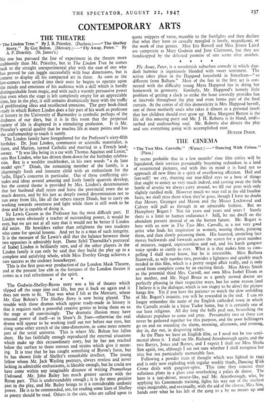THE CINEMA
"The Two Mrs. Carrolls." (Warner.)—" Dancing With Crime." (Plaza.)
IT seems probable that in a few months' time film critics will be liquidated, their services presumably becoming redundant in a land of resurrected pictures, and with this in mind it is hard not to approach all new films in a spirit of overflowing affection. Hail and farewell! we cry, shutting our tear-filled eyes to a host of things that ought to annoy us very much indeed, and casting away the little bottle of arsenic we always carry around, we fill our pens with only slightly curdled milk. However much we may rail at the old familiar faces, we shall miss them when they're gone, though I have no doubt that Messrs. Grainger and Mason and the Misses Lockwood and Calvert will pull us through in an admirable fashion. But no Humphrey Bogart ? Not for years and years and years ? Surely there is a limit to human endurance ? Still, let me dwell on the abundant present instead of on the barren future. Mr. Bogart is here with us now in The Two Mrs. Carrolls, as a not very good artist who finds his inspiration in women, wooing them, painting them, and then slowly poisoning them. His haunted, unsmiling face moves backwards and forwards across the screen for a great number of minutes, rugged, expressionless and sad, and his harsh gangster voice speaks as curtly as ever. What it is that makes him so com- pelling I shall never know, but he is irresistible. Miss Barbara Stanwyck, as wife number two, provides a lightness and sparkle much needed in this film, which is a pretty turgid affair really, and is only saved from complete coma by an exciting finish. Miss Alexis Smith as the potential third Mrs. Carroll, our own Miss Isobel Elsom as her mother, and Mr. Nigel Bruce as a gently stewed doctor are perfectly pleasing in their respective ways, but for some reason (and I believe it is the dialogue, which is too stagey to be alive) the picture hangs fire. Yet if you have the patience to watch the slow unfolding of Mr. Bogart's insanity, you will be rewarded in the end. I can no longer remember the name of the English cathedral town in which the Carrolls reside in a bijou Tudor home, but it is certainly one of our least religious. All day long the bells peal out, beseeching the obdurate populace to come and pray. Presumably two or three can never be gathered together for this purpose, and the poor bellringers go on and on sounding the alarm, morning, afternoon, and evening, day in, day out, in despairing relays.
At the Plaza we have an English film, so I need not be too senti- mental about it. I shall see Mr. Richard Attenborough again, and the two Barrys, Jones and Barnes, and I expect I shall see Miss Sheila Sim again, too, although I am not sure whether I shall recognise her nice but not particularly memorable face.
Following a powder train of thought which was lighted in 1945 and is only now exploding with regular weekly thuds, Dancing With Crime deals with gangster-spivs. This time they concoct their nefarious plans in a glass case overlooking a palais de danse. The hero is a taxi-driver, mouse-like, naif Mr. Attenborough, who, by applying his Commando training, fights his way out of the steeliest traps imaginable, and eventually, with the aid of the cheese, Miss Sun, hands over what he has left of the gang to a by no means up and corning Scotland Yard. If only I had not seen so many crime films lately I should, I know, be perfectly pleased with this one, but I confess it compares unfavourably with The Web and They Made Me a Fugitive. I realise there is little time in a thriller to go in for characterisation, but surely it should be possible to inject a little



































 Previous page
Previous page